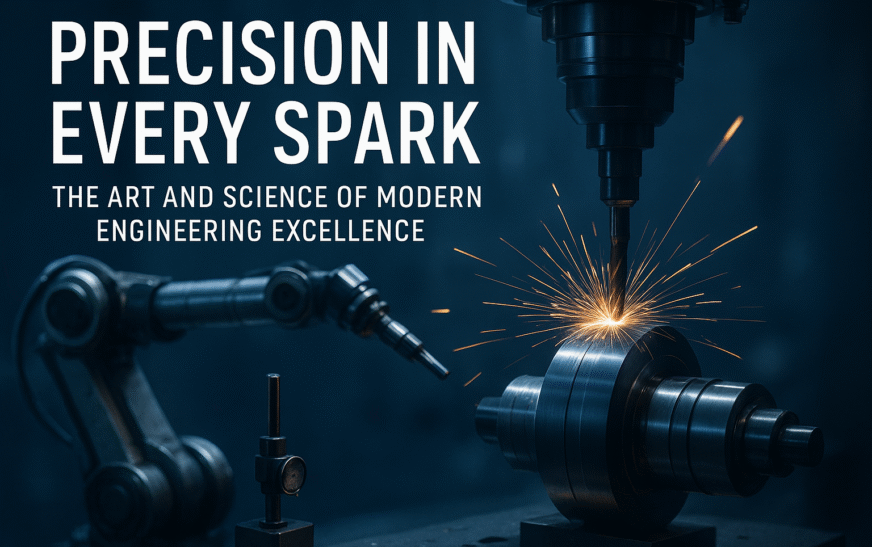The slogan, Precision in Every Spark, in the continuously changing world of technology and industrial advancement, is not merely a slogan, but a philosophy to advance progress, safety and quality in engineering, production, etc. In this scenario, precision can also be understood as not only the very careful nature of machines and processes, but also the human effort of each calculation, weld and design. Ever since the automotive sector has seen production, aerospace technology has not been left behind in terms of precision as the foundation of innovation and reliability.
The Foundation of Precision
Precision is essentially the attainment of uniformity and perfection in details. In mechanical, electronic or even computer science, precision determines the effectiveness of systems as well as the reproducibility of such systems. A spark in one engine or a circuit board might not be very significant, yet in that spark there is a narrative of evenness, time, and management.
Engineers and technicians know that every spark, both literally and figuratively, should be precisely made. In a car ignition system, say, one misfire due to imprecision will result in inefficiency or even the damaging of the engine. Equally, in electrical engineering, accurate voltage regulation will result in stability and durability of equipment. Precision is not a luxury, therefore, but it is a necessity.
Accuracy in Manufacturing and Engineering.
The modern engineering is based on the concept of measuring twice and cutting once. The number of sparks created during the welding process, cutting or machining processes of the same is closely monitored and calibrated. In production, one minute can lead to the failure of a production line. An example of this is Computer Numerical Control (CNC) machining, a product of the search to be precise. The programming of the machines operates with tolerances of micrometers ensuring precise shapes and surfaces.
The same is true of robotics and automation. The modern factories with robots are able to do repetitive work with unbelievable accuracy such that every product has high quality standards. Sensors combined with artificial intelligence and real-time monitoring have enabled the preservation of the concept of precision in every spark even in large production plants.
The use of Technology in attaining Precision.
The development of technology has transformed how industries are being precise. The data analysis is done considerably faster, the measurement systems are laser-based, and the digital twins enable engineers to identify errors in their design before they become issues. Artificial intelligence-powered predictive maintenance systems are able to detect possible problems in machines based on the vibration or energy consumption trend, ensuring the optimal performance at all times.
Under welding, the heat, angle, and time of each spark can be controlled using the computer-assisted system to give consistent output. On the same note, in the electronics industry, precision soldering is used to give a perfect connection on microscopic parts. The accuracy can be improved, as well as the waste, energy use, and downtime is minimized by these technology tools, making industrial processes more sustainable.
Human Skill Meets Machine Accuracy
Technology is important but skills of human beings cannot be substituted. Machines are directed by skilled engineers, technicians and designers. Their skills of data interpretation, anticipation of possible problems and critical adjustments, make all sparks count. Accuracy needs a complex compromise between automation and human intuition.
Education and training play a crucial role in the development of this balance. When materials, processes, and tools are familiar to professionals, it will be possible to ensure that every action leads to the overall perfection of the product. Precision, in this meaning, is an art–a manifestation of art and devotion to excellence.
Accuracy in Relatability and Sustainability.
The idea of accuracy in each spark does not only apply to the manufacturing industry but also to the energy industry. As the world shifts towards cleaner energy sources, there is need to be careful on the creation of good power systems. In solar panels, e.g., the alignment and connection of photovoltaic cells is accurate and determines the efficiency of the panel. In wind turbines, blades have to be calibrated properly to guarantee optimal functioning and security.
Besides, battery management systems of electric cars are based on the accurate control of voltage and temperature to ensure the best performance and life. With the shift towards green technologies and renewable energy in industries, it is not merely a matter of performance but a matter of accountability to the planet to always be precise on each spark.
The Future of Precision
The engineering of the future is smart precision where digital intelligence, automation, and sustainability all meet. The emergence of Industry 4.0, Internet of Things (IoT), and improved robotics has enabled unmatched precision in the industries. Both smart sensors and real time analytics can identify changes smaller than a human hair and make every operation gain optimization in terms of speed and efficiency.
With this globalized age, the slogan of Precision in Every Spark is a vision of a future of human inventions and machine-intelligence convergence. It indicates a world whereby all the elements, all the relationships, and all the activities are aligned to perfection.
Conclusion
Precision in Every Spark is not just an engineering slogan, it is a promise of high quality that is the characteristic of contemporary industry. It is the balance between technology and art, precision and invention, effectiveness and longevity. It can be a spark to an engine, a laser to metal or a circuit to a device, accuracy makes innovation shine.
With the changing of the industries and the development of the technologies, the one thing that should never change is the fact that the real excellence in life is the details. And in any seed of invention, accuracy still sheds light in the direction of an efficient, reliable and sustainable future.













